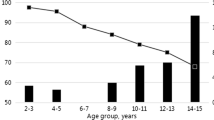Abstract
Hepatitis B has long been a serious public health problem in Greece. In recent years, a decline in hepatitis B infection is observed ascribable to many factors such as demographic and socioeconomic changes, medical precautions, use of disposable medical equipments, screening of blood donors and vaccination. We studied the prevalence of HBV infection in a sample of 1050 Greek male Navy recruits. 343 subjects (32.6%) had previously been vaccinated and were anti-HBs positive. We observed that during the last decade, the prevalence of immunes declined to 1.33% and the prevalence of any HBV marker declined to 2.28%. The HBsAg carrier rate declined from 3.9% in 1973 to 0.9% in 1986. Since then, it is stable at 0.95% because perinatal and vertical transmissions are still responsible for the majority of HBV chronic infections. Universal prenatal screening and infant immunization will contribute to a further decline of HBV infection.
Similar content being viewed by others
References
Papaevangelou G, Kyriakidou A, Vissoulis C, Trichopoulos D. Seroepidemiological study of HBV infections in Athens, Greece. J Hyg (Lond) 1976; 76: 229–234.
Crovari P. Epidemiology of viral hepatitis B in Italy. Vaccine 1995; 13(Suppl 1): S26–S30.
Roure C. Overview of epidemiology and disease burden of hepatitis B in the European region. Vaccine 1995; 13(Suppl 1): S18–S21.
Papaevangelou G. Perspectives on viral hepatitis elimination in Europe. In: Nishioka K, Suzuki H, Mishiro S, Oda T (eds), Viral hepatitis and liver disease. Tokyo: Springer-Verlag, 1994: 435–438.
Mantero G, Zonaro A, Albertini A, Bertolo P, Primi D. DNA enzyme immunoassay: General method for detecting products of polymerase chain reaction. Clin Chem 1991; 37: 422–429.
Papaevangelou G, Farmaki G, Kada H. Hepatitis B maternal-foetal transmission in Southern Europe. Intervirology (accepted for publication).
Iwarson S, Jilg W, Stroffolini T. Substantial decline of notified hepatitis B in major parts of Europe after 1985. Scand J Infect Dis 1994; 26: 19–22.
Jilg W. Selective risk group strategies in Europe. Vaccine 1995; 13(Suppl 1): S44–S46.
D'Amelio R, Matricardi PM, Biselli R, Stroffolini T, Mele A, Spada E, Chionne P, Rapicetta M, Ferrigno L, Pasquini P. Changing epidemiology of hepatitis B in Italy: Public health implications. Am J Epidemiol 1992; 135: 1012–1018.
Kane M. Global programme for control of hepatitis B infection. Vaccine 1995; 13(Suppl 1): S47–S49.
Kattamis C, Papaevangelou G. Workshop group: Greece. Vaccine 1995; 13(Suppl 1): S97–S98.
Newspaper of the Government of the Hellenic Republic, No 856, September 25 1997.
Author information
Authors and Affiliations
Rights and permissions
About this article
Cite this article
Stamouli, M., Gizaris, V., Totos, G. et al. Decline of hepatitis B infection in Greece. Eur J Epidemiol 15, 447–449 (1999). https://doi.org/10.1023/A:1007539517341
Issue Date:
DOI: https://doi.org/10.1023/A:1007539517341




